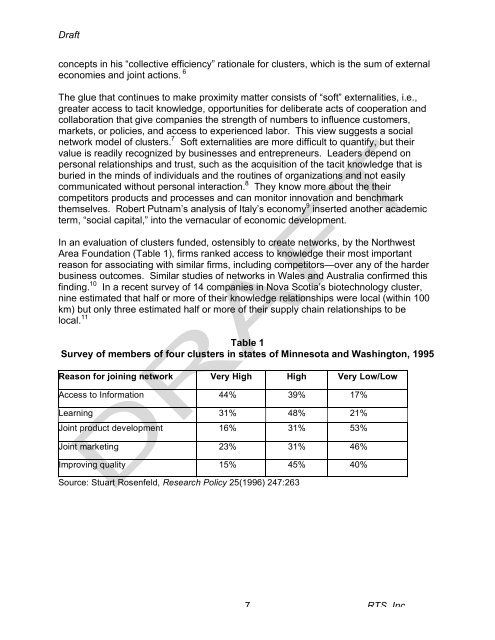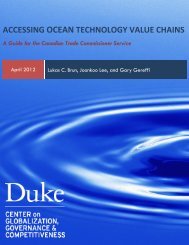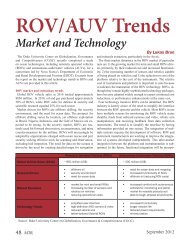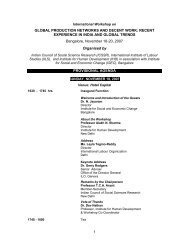Paper - Center on Globalization, Governance & Competitiveness
Paper - Center on Globalization, Governance & Competitiveness
Paper - Center on Globalization, Governance & Competitiveness
Create successful ePaper yourself
Turn your PDF publications into a flip-book with our unique Google optimized e-Paper software.
Draft<br />
c<strong>on</strong>cepts in his “collective efficiency” rati<strong>on</strong>ale for clusters, which is the sum of external<br />
ec<strong>on</strong>omies and joint acti<strong>on</strong>s. 6<br />
The glue that c<strong>on</strong>tinues to make proximity matter c<strong>on</strong>sists of “soft” externalities, i.e.,<br />
greater access to tacit knowledge, opportunities for deliberate acts of cooperati<strong>on</strong> and<br />
collaborati<strong>on</strong> that give companies the strength of numbers to influence customers,<br />
markets, or policies, and access to experienced labor. This view suggests a social<br />
network model of clusters. 7 Soft externalities are more difficult to quantify, but their<br />
value is readily recognized by businesses and entrepreneurs. Leaders depend <strong>on</strong><br />
pers<strong>on</strong>al relati<strong>on</strong>ships and trust, such as the acquisiti<strong>on</strong> of the tacit knowledge that is<br />
buried in the minds of individuals and the routines of organizati<strong>on</strong>s and not easily<br />
communicated without pers<strong>on</strong>al interacti<strong>on</strong>. 8 They know more about the their<br />
competitors products and processes and can m<strong>on</strong>itor innovati<strong>on</strong> and benchmark<br />
themselves. Robert Putnam’s analysis of Italy’s ec<strong>on</strong>omy 9 inserted another academic<br />
term, “social capital,” into the vernacular of ec<strong>on</strong>omic development.<br />
In an evaluati<strong>on</strong> of clusters funded, ostensibly to create networks, by the Northwest<br />
Area Foundati<strong>on</strong> (Table 1), firms ranked access to knowledge their most important<br />
reas<strong>on</strong> for associating with similar firms, including competitors—over any of the harder<br />
business outcomes. Similar studies of networks in Wales and Australia c<strong>on</strong>firmed this<br />
finding. 10 In a recent survey of 14 companies in Nova Scotia’s biotechnology cluster,<br />
nine estimated that half or more of their knowledge relati<strong>on</strong>ships were local (within 100<br />
km) but <strong>on</strong>ly three estimated half or more of their supply chain relati<strong>on</strong>ships to be<br />
local. 11<br />
Table 1<br />
Survey of members of four clusters in states of Minnesota and Washingt<strong>on</strong>, 1995<br />
Reas<strong>on</strong> for joining network Very High High Very Low/Low<br />
Access to Informati<strong>on</strong> 44% 39% 17%<br />
Learning 31% 48% 21%<br />
Joint product development 16% 31% 53%<br />
Joint marketing 23% 31% 46%<br />
Improving quality 15% 45% 40%<br />
Source: Stuart Rosenfeld, Research Policy 25(1996) 247:263<br />
7<br />
RTS, Inc.
















